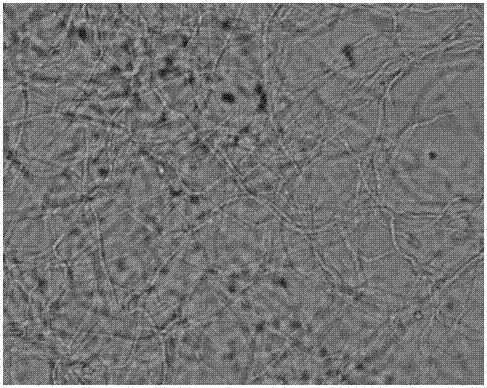Biocontrol actinomycetes strain for controlling pepper phytophthora blight, and application of strain
A technology of pepper blight and actinomycetes, applied in the direction of application, bacteria, and biocides, can solve problems such as unsatisfactory chemical control effects and environmental pollution, achieve good development and application prospects, reduce farmland pollution, and effectively prevent and control pepper blight Effect
- Summary
- Abstract
- Description
- Claims
- Application Information
AI Technical Summary
Problems solved by technology
Method used
Image
Examples
Embodiment 1
[0026] Example 1 Isolation of Antagonistic Actinomycetes
[0027] The specific process is as follows:
[0028] 1. Collection of soil samples
[0029] The rhizosphere soil at a depth of 5-10 cm from different hot pepper plots was collected from Kunkou Village, Dongfeng Town, Jian'ou City, Fujian Province, packed and marked, brought back to the laboratory, and separated after natural air-drying.
[0030] 2. Isolation of actinomycetes
[0031] Separation was performed using the plate dilution method. Weigh 10 g of the soil sample, pour it into a conical flask filled with small glass beads and 90 ml of sterile water, shake it for 30 min, then let it stand for 5 minutes, dilute it by 10 times successively, and prepare 10 -2 、10 -3 、10 -4 、10 -5 、10 -6 Suspension of different concentrations, each 0.1 ml of the suspension was drawn and added to Gao's No. 1 medium (add K with a final concentration of 50 mg / L 2 Cr 2 o 7 ) plate, spread evenly and culture at 28°C for observati...
Embodiment 2
[0032] Identification of embodiment two bacterial strain St19
[0033] 1. Observation of morphological characteristics
[0034] The strain St19 was streak-inoculated on Gao's No. 1 medium, inserted into a sterile cover glass at 45 °C obliquely, and cultured at 28 °C for 10 days, then the cover glass was taken out to observe the morphological characteristics of the hyphae under an optical microscope and an electron microscope ( figure 1 with figure 2 ).
[0035] 2. Observation of culture characteristics
[0036] Using the 8 kinds of media recommended in the Streptomyces Identification Manual, culture the strain St19 at 28 °C for 7-10 days, observe the growth of the bacteria, and record the color of the aerial hyphae and basal hyphae and whether soluble pigments are produced. Strain St19 grew well on Gao's No. 1 medium, Chabek medium, starch ammonium medium, PDA medium, glucose yeast extract medium and oat medium, and the hyphae and aerial hyphae in the substrate developed ...
Embodiment 3
[0041] The optimization of embodiment three St19 bacterial strain fermentation technology
[0042]The above strains were inoculated in Gaoshi No. 1 liquid medium, cultured at 28 °C and 200 r / min for 2 days, then made into seed liquid, and inoculated in the fermentation medium. Taking Phytophthora capsici as the target bacteria, through the screening of carbon source and nitrogen source, single factor test and orthogonal test of nutritional conditions, the optimal fermentation formula of this strain is obtained: soluble starch 2%wt, glucose 1.5%wt, Soybean flour 2%wt, MgSO 4 ·7H 2 O 0.05%wt, K 2 HPO 4 0.1%wt, NaCl 0.1%wt, CaCO 3 0.2%wt, the rest is distilled water. The optimal fermentation conditions were: inoculum volume 6% vol, bottle volume 70 mL / 250 mL, initial pH value of fermentation medium 7.0, 28°C, 200 r / min, fermentation time 5 days, and a concentration of 10 8 CFU / ml of St19 strain fermentation broth. After the fermentation broth was centrifuged at 4000 r / mi...
PUM
 Login to View More
Login to View More Abstract
Description
Claims
Application Information
 Login to View More
Login to View More - R&D Engineer
- R&D Manager
- IP Professional
- Industry Leading Data Capabilities
- Powerful AI technology
- Patent DNA Extraction
Browse by: Latest US Patents, China's latest patents, Technical Efficacy Thesaurus, Application Domain, Technology Topic, Popular Technical Reports.
© 2024 PatSnap. All rights reserved.Legal|Privacy policy|Modern Slavery Act Transparency Statement|Sitemap|About US| Contact US: help@patsnap.com










